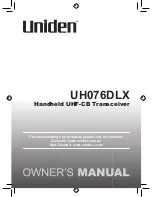
RLX-FHE, RLX-FHES, RLX-FHS
♦
RadioLinx FH
Network Installation Plan
Frequency-Hopping Industrial Radio
Page 30 of 151
ProSoft Technology, Inc.
November 25, 2008
Add repeater to extend distance or where line of sight is limited
Radios or antennas CANNOT be places within 20 cm of where people will be
Though radio frequency communication is reliable, sometimes its performance
can be impacted by intangibles. A good network installation plan includes
time
and
resources
for performance testing and installation changes.
Test the installation plan (page 49) before the network installation is complete.
4.3
Sources of Interference
The RadioLinx radio modem operates more reliably than a radio using
conventional technology due to the frequency hopping spread spectrum
technique. While RadioLinx radios are less susceptible to interference due to this
technique, interference (radio "noise") may still occur. Radios are designed to
detect specific radio frequencies. An "interferer" is an unwanted signal that has
been transmitted at the same frequency that the radio was designed to detect.
There are many man-made and natural sources of electromagnetic interference
(lightning, power lines, switching power supplies, fluorescent lighting, microwave
ovens, cordless phones, etc.). To decrease the effects of interference on network
function:
Use a directional (high gain) antenna at the Remote radio locations, if
possible
Verify that each network operating in close proximity to each other has BEEN
ASSIGNED TO A DIFFERENT CHANNEL (page 78)
Install networks in rural areas (if at all possible) where they will likely
encounter less man-made noise than in urban or suburban areas
Enable
encryption
Change a radio's network output power (refer to the Radio Settings -
Transmit Power sections in the Radio Configuration (page 71) screens for
each type of network):
o
Increase
power to "drown out" competing noise
o
Decrease
power of the radios on the network if they are interfering with
another network in the vicinity
















































